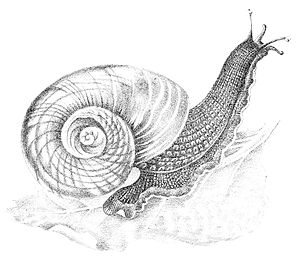Paryphanta
| Paryphanta | ||||||||||||
|---|---|---|---|---|---|---|---|---|---|---|---|---|

Paryphanta busbyi , drawing from JC Cox , 1888. |
||||||||||||
| Systematics | ||||||||||||
|
||||||||||||
| Scientific name | ||||||||||||
| Paryphanta | ||||||||||||
| Albers , 1850 |
Paryphanta is the name of a genus predatory living snails from the family Rhytididae in the subordination of terrestrial snails (gastropod), which in New Zealand are common. While in the past all species of the genus Powelliphanta were grouped together in this genus, today only two species - Paryphanta busbyi and Paryphanta watti - are counted in this genus.
features
The shell of snails in the genus Paryphanta, which is always bifurcated, is mostly flattened and greenish-brown to blackish in color. While the lime layer is thin, there is a strong periostracum made of conchin that covers the mouth of the case. The radula usually has a central tooth and numerous single-pointed posterior teeth. As with the other Rhytididae, there are no pine trees. The foot is wide and ends in an oval shape.
Distribution and occurrence
The snails of the genus Paryphanta are common in New Zealand .
Life cycle
The snails of the genus Paryphanta , like all lung snails, are hermaphrodites . After two snails have mated and exchanged their sperm, both snails lay their white, oval eggs with a strong lime shell - but without the cuticula characteristic of Powelliphanta - in leaf litter. Only about 6 eggs are laid each year. The snails can live for around 20 years.
nutrition
The snails of the genus Paryphanta feed as carnivorous snails mainly on earthworms , which they use the Radulazähne hold and pull into her mouth. In addition, snails are also preyed , especially from the genus Athoracophorus .
Systematics
The numerous species of the genus Powelliphanta were previously included in the genus Paryphanta , with whose representatives they are closely related. Today only two species are counted in the genus Paryphanta : Paryphanta busbyi and Paryphanta watti , which occur in the areas from North Cape to West Auckland. Here comes Paryphanta Watti only in the extreme north of the area in Kaeo on. This species is much darker and often smaller than Paryphanta busbyi , but it can reach their size when it gets old enough.
Common name in New Zealand
The snails of the genus Paryphanta are called kauri snails or pupurangi in New Zealand . They must not be confused with the sea snails known as cowries .
literature
- Arthur William Baden Powell : New Zealand Mollusca , William Collins Publishers Ltd, Auckland 1979. ISBN 0-00-216906-1
Web links
Individual evidence
- ^ O. von Möllendorff: Agnatha Moerch. Predator snails. 2. Genus Paryphanta Alb., P. 10. In: O. von Moellendorff and Wilhelm Kobelt: Die Raublungenschnecken (Agnatha). Systematic Conchylia Cabinet by Martini and Chemnitz. Verlag von Bauer and Raspe (Emil Küster), Nuremberg 1905.
- ^ Arthur William Baden Powell : New Zealand Mollusca . William Collins Publishers Ltd, Auckland 1979. ISBN 0-00-216906-1
- ^ A b C. A. McGuinness (2001): The conservation requirements of New Zealand's nationally threatened invertebrates ( Memento of October 15, 2008 in the Internet Archive ). Threatened Species Occasional Publication 20. 658 pages. Pp. 71-120.
- ^ Spencer Marshall and Willan: Gastropoda.
- ↑ Kauri Snails. Department of Conservation, New Zealand.